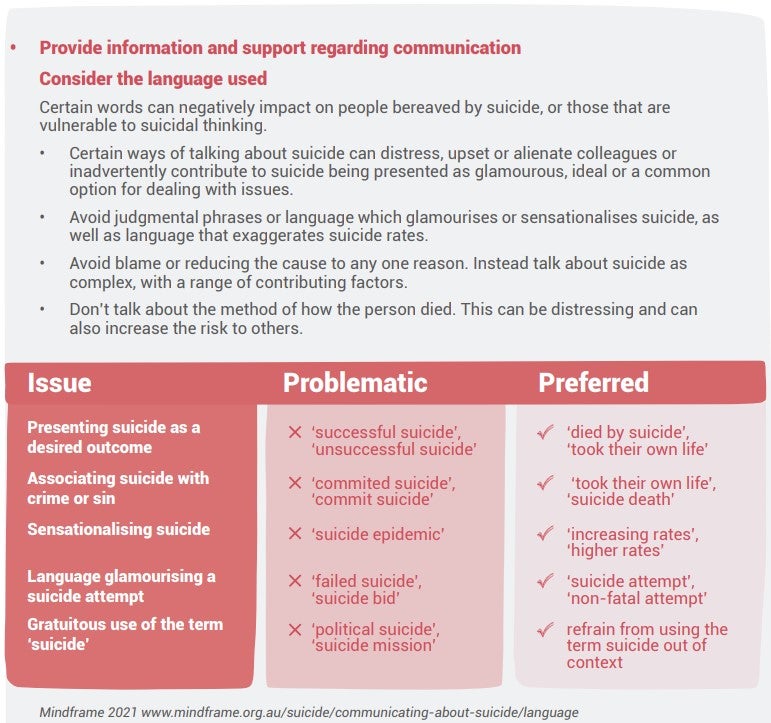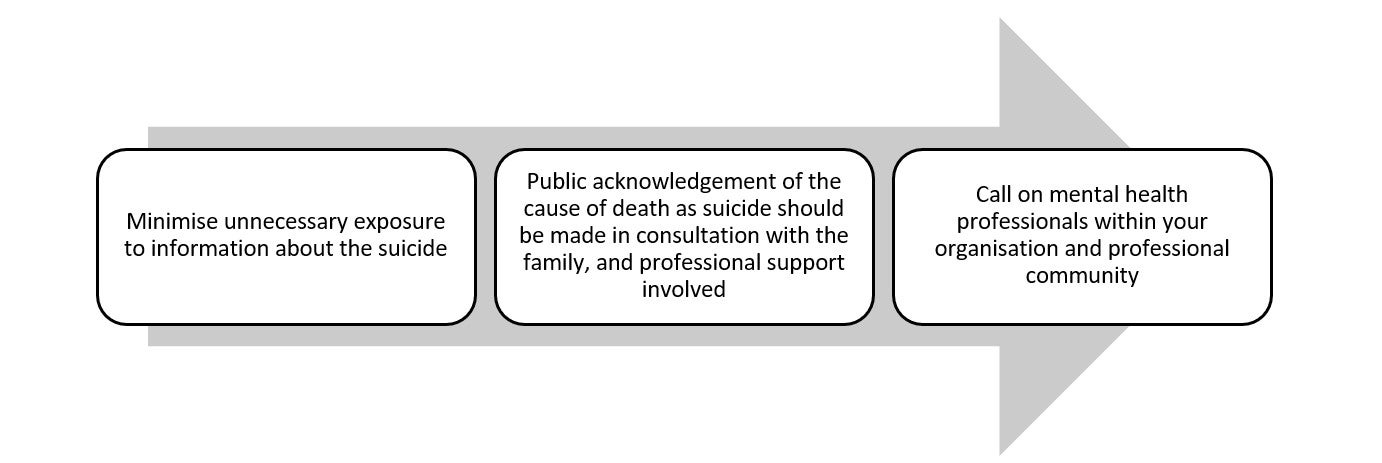- within Employment and HR topic(s)
- with Senior Company Executives, HR and Finance and Tax Executives
- in United States
- with readers working within the Basic Industries, Business & Consumer Services and Environment & Waste Management industries
Trigger warning: Some people may find parts of this content confronting or distressing. If this material raises concerns for you, please contact Lifeline on 13 11 14 and/or your trusted health professional.
One of the most challenging parts (and privileges) of our roles as work health and safety (WHS) lawyers is supporting an organisation when there has been a tragic loss of life.
In the last few years that support has increasingly included providing WHS legal advice following a suicide.
Lawyers' articles about workplace deaths mainly address handling visits from inspectors, since our job is to advise on managing WHS legal risks.
This article seeks to do something different. Our aim is to share links to valuable resources and provide an overview of some of the key themes from those resources on managing the profound human impacts in these devastating cases.
Understand key terms like postvention
Postvention in the workplace context "focuses on mitigating
negative outcomes for individuals and the work environment and
supporting the work of a [workplace] community in a healing
process, to rebuild resilience and morale. This support can include
a range of activities from those as simple as ensuring access to a
quiet room for 'time out', the provision of support
information, or more structured support such as employee assistance
program, counselling, support groups, etc. The aim is to alleviate
or reduce risk of negative workplace outcomes such as low morale,
low productivity, absenteeism, staff conflict and many other
wellbeing issues."2
Suicide grief is different
It has been recognised that suicide bereavement involves a complicated mix of grief and stress that can differ from other types of grief because of stigma often associated with suicide, and high levels of shame, guilt and/or social isolation.
This difference should be considered during postvention.
Don't make assumptions about who will be impacted
The StandBy workplace toolkit tells us that "Suicide is impactful, particularly for those who had a perceived close relationship. In a work environment, it is worth noting that some workers may spend more time with colleagues than with family members. It is important not to presume knowledge of what, if any, connections employees have formed during their working life and what they mean to the individual. Additionally, consideration should also be given in the event of sudden death of a client / customer and the subsequent impacts on workers, case managers and others."
Consider all affected workers and individuals during postvention.
Proactive suicide postvention planning is essential
Responding to a suicide is challenging without prior planning.
Experts3 suggest that organisations consider the following during planning:
- identify and delineate tasks, roles and responsibilities for the postvention (note that members of the postvention team should have an opportunity to opt out if they are impacted by the death, or feel they are unable to undertake responsibilities)
- engage with mental health services experts (including specialised postvention service providers) during the development of the plan
- prepare communications and scripts for sharing information with the support of experts. Key considerations include protecting the privacy of the family, and not informing people unexpectedly or in an unsafe environment
- the workforce is diverse. Seek guidance from cultural or religious groups with experience in culturally sensitive responses to suicide. It is important to also consider the LGBTIQ+ community in your planning.
Consult with workers and experts
Don't forget to consult with your workforce and subject matter experts, through existing WHS consultative arrangements, about the plan.
Communication
Be mindful of your language in communications. StandBy's guidance is outlined below:

Mindframe – Communicating about suicide
guidance is set out below:

Keep an eye on the internet
When people who are not closely connected with the person discuss the death, speculation and misinformation can spread quickly.
StandBy recommends the following:
- monitor and respond to conversations online
- public posts aren't the ideal form of communication about suicide, consider who might view this online content before posting information
- while online may not be the ideal place for conversations, it does provide an opportunity to engage with people talking about the death and provide accurate information and links of where people can get further support
- if possible, conversations online should be monitored, and contents and comments moderated by someone with knowledge in suicide bereavement.
Don't forget about self-care for those in charge of the response
The response team should regularly meet to review processes, assess possible improvements, and discuss self-care or support needs, including their own.
Long-term support is essential
Remember to:
- plan for anniversaries or other significant events
- continue to identify, monitor and support people at risk and promote help seeking behaviours
- regularly review and update the response plan.
Prevention must remain a focus
Although this article addresses postvention, prevention should always be a priority. Here are some essential sources for prevention information for the APS:
People and Culture and WHS teams should access credible resources to guide their responses
Here are some resources to guide you through this challenging issue:
- Suicide Aware – Neami National
- Thirrili
- Black Dog Institute – Workplace Suicide Prevention
- StandBy – Support After Suicide Toolkit
- Postvention Australia – Research and Guidelines
- National Suicide Prevention Office
Support
Support is always available. If you or someone you know is experiencing distress, please contact one of the options below for information and support in Australia.
Lifeline
13 11 14
lifeline.org.au
ReachOut
au.reachout.com
Headspace
1800 650 890
headspace.org.au
Beyond
1300 224 636
Beyondblue.org.au
Defence Member and Family Helpline
1800 624 608
https://www.defence.gov.au/adf-members-families/crisis-support/helplines/defence-member-family-helpline
Kids Helpline
1800 551 800
kidshelpline.com.au
Suicide Call Back Service
1300 659 467
Suicidecallbackservice.org.au
QLife
1800 184 527
qlife.org.au
MensLine Australia
1300 789 978
mensline.org.au
Open Arms
1800 011 046
Openarms.gov.au
Medicare Mental Health
1800 595 212
https://www.medicarementalhealth.gov.au/
13YARN
13YARN (13 92 76)
Healthinfonet.ecu.edu.au
Footnotes
1 Ridani, R., Torok, M., Shand, F., Holland,
C., Murray, S., Borrowdale, K., Sheedy, M., Crowe, J., Cockayne,
N., Christensen, H. (2016). An evidence-based systems approach to
suicide prevention: guidance on planning, commissioning, and
monitoring, Black Dog Institute, Sydney.
2 StandBy Workplace toolkit Workplace response to
suicide, 2024 page 7.
3 StandBy Workplace toolkit Workplace response to
suicide, 2024 page 10, A Guide for AFL Clubs Impacted by Suicide,
2023.
This publication does not deal with every important topic or change in law and is not intended to be relied upon as a substitute for legal or other advice that may be relevant to the reader's specific circumstances. If you have found this publication of interest and would like to know more or wish to obtain legal advice relevant to your circumstances please contact one of the named individuals listed.



